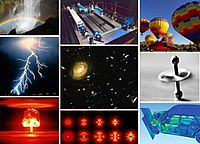
Photo from wikipedia
In the sequence of ‘standard’ Physics undergraduate course contents, group theory is typically relegated to the edges— its importance is acknowledged, and perhaps a few significant results are provided, but… Click to show full abstract
In the sequence of ‘standard’ Physics undergraduate course contents, group theory is typically relegated to the edges— its importance is acknowledged, and perhaps a few significant results are provided, but the topic is rarely subjected to in-depth examination in class. This is unfortunate, because group theoretical methods have illuminated much of modern physics. For the Physics instructor who wishes to bring some Group Theory into a physics class (for whatever reason), there are precious few reference texts that are suitable for either the beginner or non-expert, and surely this hampers educators’ efforts to modernise and improve the Physics curriculum. The authors of Group Theory in Physics set out from the beginning to provide such a reference work, and they have succeeded in their effort. After an initial chapter ‘Generalities’ providing basic definitions and theorems concerning algebraic structures and topological spaces, the authors provide 2 chapters covering finite groups,which are typically applied to crystallographic symmetries. The next 7 chapters are concerned with continuous (Lie) groups and Lie algebras. Here, the ‘usual’ introduction is in the context of spatial rotations. The final 4 chapters discuss other groups and symmetries: spacetime symmetries, kinematical groups and algebras, and lastly internal (gauge) symmetries. The basic question to be answered in this review is ‘is this book truly a “practitioner’s guide”, as explicit in the title’? Happily, the answer is ‘Yes’. For example, I especially appreciate the numerous examples throughout the text that explicitly apply various aspects of representation theory to physical problems of interest as they really clarify the underlying mathematics. It is likely that this book will find an appreciative audience of educators and graduate students.
Journal Title: Contemporary Physics
Year Published: 2019
Link to full text (if available)
Share on Social Media: Sign Up to like & get
recommendations!